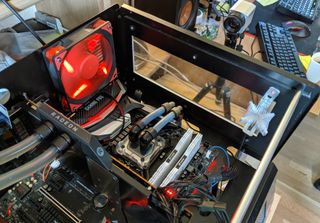RX 5700 XT Overclocked to 2.2 GHz With Just 15% More Power

AMD's recently-launched Radeon RX 5700 series surprised us in regards to performance and power efficiency and was able to keep up with Nvidia for the first time in a long time, though it's clear that the reference cooler is holding it back in regards to clock speed. Igor Wallossek, the editor-in-chief of our German-based counterpart, Tom's Hardware Germany, went about outfitting the 5700 XT with a liquid cooler and found that the Navi-based RX 5700 XT is actually quite an impressive overclocking GPU.
Using the powerplay tables method of overclocking AMD GPUs, Wallossek was able to get a 5700 XT to boost to 2.2 GHz, though it averaged a clock speed slightly lower than that. Still, it's an impressive result considering the 5700 XT only averages a clock speed slightly above 2 GHz, with drops well below that threshold at times.
You might be thinking the 5700 XT is under liquid cooling because it has to be, or it would thermal throttle, but this overclock didn't really push the 5700 XT very hard. This ~10% overclock only required ~15% more power, which is a far cry from the massive power draw required to push previous Vega-based GPUs (even including the Radeon VII that's based on the same 7nm process). For an overclock of this caliber, you hardly need a liquid cooler, just a decent aftermarket air cooler.
Wallossek's testing bodes very well for future RDNA GPUs and other Navi-based GPUs coming sooner, seeing as the 5700 XT overclocks well without needing very much additional power. Overclockers may consider waiting for custom cards to arrive from AMD's partners, or consider picking up a cheaper air cooler for their GPU from companies like Arctic.
Stay on the Cutting Edge
Join the experts who read Tom's Hardware for the inside track on enthusiast PC tech news — and have for over 25 years. We'll send breaking news and in-depth reviews of CPUs, GPUs, AI, maker hardware and more straight to your inbox.
Matthew Connatser is a freelancing writer for Tom's Hardware US. He writes articles about CPUs, GPUs, SSDs, and computers in general.
-
koblongata Navi is gonna dominate even the high end graphics card space... and stay dominant until second quarter 2020... When nVidia's Ampere line finally comes out.Reply
Most Popular


